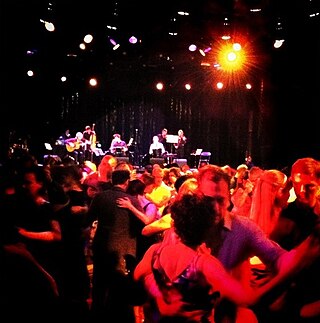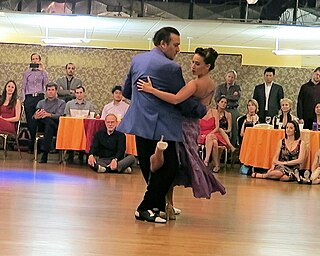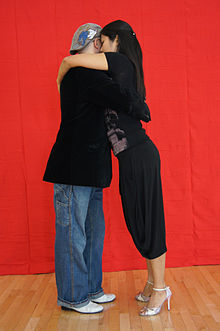
Astor Pantaleón Piazzolla was an Argentine tango composer, bandoneon player, and arranger. His works revolutionized the traditional tango into a new style termed nuevo tango, incorporating elements from jazz and classical music. A virtuoso bandoneonist, he regularly performed his own compositions with a variety of ensembles. In 1992, American music critic Stephen Holden described Piazzolla as "the world's foremost composer of Tango music".

Tango is a partner dance and social dance that originated in the 1880s along the Río de la Plata, the natural border between Argentina and Uruguay. The tango was born in the impoverished port areas of these countries from a combination of Argentine Milonga, Spanish-Cuban Habanera, and Uruguayan Candombe celebrations. It was frequently practiced in the brothels and bars of ports, where business owners employed bands to entertain their patrons. It then spread to the rest of the world. Many variations of this dance currently exist around the world.

Tango is a style of music in 2
4 or 4
4 time that originated among European and African immigrant populations of Argentina and Uruguay. It is traditionally played on a solo guitar, guitar duo, or an ensemble, known as the orquesta típica, which includes at least two violins, flute, piano, double bass, and at least two bandoneóns. Sometimes guitars and a clarinet join the ensemble. Tango may be purely instrumental or may include a vocalist. Tango music and dance have become popular throughout the world.

Candombe is a style of music and dance that originated in Uruguay among the descendants of liberated African slaves. In 2009, the United Nations Educational, Scientific and Cultural Organization (UNESCO) inscribed candombe in its Representative List of the Intangible Cultural Heritage of Humanity.
Nuevo tango is both a form of music in which new elements are incorporated into traditional tango music, and an evolution of tango dance that began to develop in the 1980s.

Carlos Di Sarli was an Argentine tango musician, orchestra leader, composer and pianist.

Argentine tango is a musical genre and accompanying social dance originating at the end of the 19th century in the suburbs of Buenos Aires. It typically has a 2
4 or 4
4 rhythmic time signature, and two or three parts repeating in patterns such as ABAB or ABCAC. Its lyrics are marked by nostalgia, sadness, and laments for lost love. The typical orchestra has several melodic instruments and is given a distinctive air by the bandoneon. It has continued to grow in popularity and spread internationally, adding modern elements without replacing the older ones. Among its leading figures are the singer and songwriter Carlos Gardel and composers/performers Francisco Canaro, Juan D'Arienzo, Carlos Di Sarli, Osvaldo Pugliese, and Ástor Piazzolla.

Milonga is an event where Argentine tango is danced. The venue dedicated to milongas may also be called "milonga". People who frequently go to milongas may be called milongueros.

Tango, a distinctive tango dance and the corresponding musical style of tango music, began in the working-class port neighborhoods of Buenos Aires (Argentina) and Montevideo (Uruguay); on both sides of the Rio de la Plata.

Mariano Chicho Frúmboli is an Argentinian tango dancer. He is regarded as one of the founders of tango nuevo, and he is best known for his musicality and creativity while improvising.
Susana Miller is an Argentine tango professional who is one of the most prominent teachers and dancers of the modern milonguero style of tango. She introduced the term Milonguero Style in the mid 1990s when she was assisted by Cacho Dante, Pedro 'Tete' Rusconi, and other milongueros with whom she collaborated to develop a new didactic and system to teach tango. Born in Buenos Aires, Miller continues to teach there as well as internationally.

Pedro Florindo Sassone was an Argentinian violinist and composer, leader of his eponymous orchestra, which played tango music, from the 1940s up to the 1970s.

Gustavo Naveira is an Argentine tango dancer and teacher who contributed to the detailed analysis of the movements of dancing to Argentine tango.
Queer Tango is to dance Argentine tango without regard to the traditional heteronormative roles of the dancers, and often to exchange the leader and follower roles. Therefore, it is related to open role or same-sex tango. The queer tango movement permits not only an access to tango for the LBGTQIAA+ community, but also supports female leaders and male followers, regardless of sexual orientation.
Figures of Argentine tango are elements of Argentine tango.

A milonguero is a person who spends time dancing social tango. The word comes from the term milonga referring to a tango dance event.

Milonga dance is dancing to milonga music.

Alberto Bernardino Paz was an Argentine tango historian, teacher, and dancer. Alberto taught the traditional, social tango of the Buenos Aires salons, together with its codes and culture, to North Americans and Europeans.

Tango Argentino is a musical stage production about the history and many varieties of Argentine tango. It was created and directed by Hector Orezzoli and Claudio Segovia, and premiered at the Festival d'Automne in Paris in 1983 and on Broadway in New York in 1985. The Mel Howard production became a world-wide success with numerous tours culminating with a Broadway revival in 1999–2000. It set off a world-wide resurgence of tango, both as a social dance and as a musical genre. Tango Argentino recreates on stage the history of tango from its beginnings in 19th-century Buenos Aires through the tango's golden age of the 1940s and 50s up to Piazzolla's tangos. Most of the dancers in the show did their own choreography.
Nardo Zalko was an Argentine-French journalist, author, researcher, and historian of tango.
















